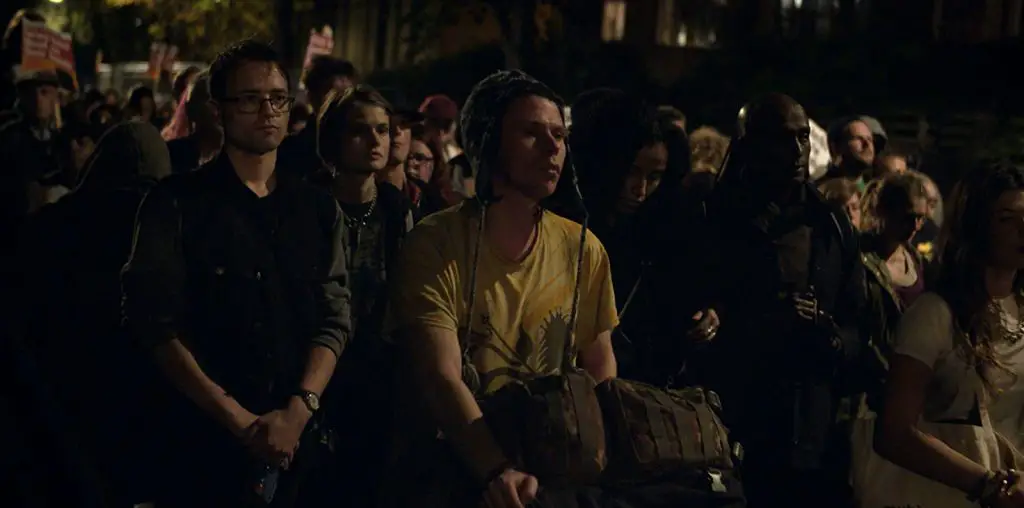
Neil Slavin’s merry-go-round of apology affectionately titled “Focus”, bearing the same name as the Arthur Miller novel that it was adapted from, is an exercise in near implausibility and should be re-titled “How to be an Anti-Semite and not offend anyone.”
In “Focus” William H. Macy (true to form the role comes complete with self-loathing and non-acknowledgement of the obvious) portrays Lawrence Newman a corporate yes-man and momma’s boy who has spent the better half of his waking-life walking the moral tightrope know as the middle road and heeding to conventional wisdom’s of God, mother & country. Set in the closing months of WW II, Lawrence finds himself under upper management scrutiny because he, unbeknownst to himself, has hired a Jew. Lawrence is coerced into acquiring a pair of glasses, but not just any pair of glasses, ones that make him appear Jewish. Complicating matters is Gertrude (Dern) who has come to the firm looking for employment. Though Laura Dern’s long-nylon clad-legs and statuesque figure seem to have the ability to arouse many any object, the only thing that truly surfaces is Lawrence’s suspicions. The assumption (conveniently provided by Dern’s character in finger pointing agony) is that she may be Jewish due to her appearance. More tension is caused by Lawrence’s next-door neighbor Fred (Meatloaf acting extremely well) who is apparently a serious anti-Semite (though seemingly unable to afford a swastika, rebel flag or a burning cross) that has taken up issue with a Jewish storeowner Finkelstein (Paymer).
Director Slavin has crafted a deftly noir film where he is quite at home with the conventions of noir and has a much greater understanding of the components and asceticism of noir than say a certain former video store clerk. But the well intended genre-bending analysis in “Focus” falls flat in several respects. At no point are you conclusively convinced that Lawrence is an anti-Semite or for that matter has any real racial or religious discriminatory preferences.
Instead this film walks the line and confuses the agendas of Lascelles’ script and Mr. Miller’s novel. More bothersome than this is the politeness of Fred (Meatloaf) and his band of Christian Crusaders. So nice are they in their hatred that will not name-call in a minorities presence, prefer to restrict their hate-mongering actions to the night (lest they create embarrassment by causing a scene) and deny these actions when confronted by Lawrence so that their friendship does not become awkward. Wrapped around this is the relationship that blooms between Lawrence and Gertrude. Though Slavin is careful to explain their juxtaposition with body language and dialogue the resolution and resulting marriage happens at too breakneck of a pace to be believable between two characters that were so immediately divided along lines of religion.
The problematic nature of “Focus” could be attributed to the fact the Kendrew Lascelles is referencing a work written in 1947. This film suffers from the problem that plagues most films about race; it lacks the desire and ability to show the ugliness and brutality of discrimination. In a time where black men are dragged to death behind pick-up trucks, homosexuals are chained to fences to die of exposure and Asian exchange students are shot dead when mistaking the address of a Halloween party; it is hard for “Focus” to have any shock value. And when compared with any of the cop dramas running in syndication or films like “American History X” it falls extremely short of the mark.
But had these problems been overcome you are still faced with a film where the allegiances are never clear. For starters it is indicated quite early on that Lawrence has enjoyed a health friendship with Fred and Finkelstein. It is never made clear at what point the tide began to change. More bothersome than that is Lawrence having a black housekeeper, which tends to indicate that Lawrence and his abrasive mother are not really that discriminatory after all. Nonetheless without clear lines of conflict or resolution what is left is a painfully dated pseudo-inspection of America’s problems with discrimination.
The most effective and understated aspect of this film is its comment on suburbia and American values. Lascelles takes an unabashed attack at the so-called values and standards that contemporary presidents mourn the death of. He effortlessly shows that all is not right in the pristine neighborhoods and on the impeccable streets of Anyplace, USA. But, this powerful exposition is lost in a toothless commentary with unclear objectives.


